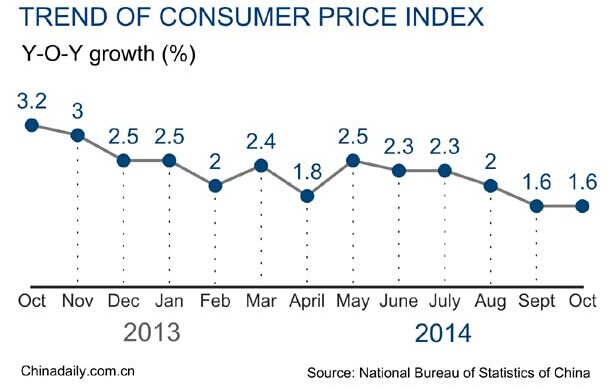

China's consumer inflation rate remained at its lowest level since January 2010, while factories' wholesale prices contracted for a 32nd straight month, official data for October showed.
The latest retail and wholesale consumption figures suggested weak domestic demand, falling commodity prices, subdued manufacturing activity and lingering overcapacity in the Chinese economy, analysts said.
CPI INFLATION EASES
China's consumer price index (CPI), a main gauge of inflation, grew 1.6 percent year on year in October, the National Bureau of Statistics (NBS) said in a statement on Monday.
The inflation index was in line with the consensus projection, and was the same as that of September, which was the lowest since January 2010.
On a monthly basis, the October inflation index was flat against the previous month, compared with September's 0.5-percent increase, NBS data showed.
For the first 10 months, inflation grew 2.1 percent year on year, well below the 3.5-percent full-year target set by the government.
Yu Qiumei, a senior NBS statistician, said higher food prices were the main contributor to CPI growth last month.
Food prices, which account for about one-third of the weighting in the CPI calculation, rose 2.5 percent from a year ago in October, lifting the CPI by 0.83 percentage points.
In the food category, the price of fresh fruit surged 15.2 percent, increasing the CPI by 0.3 percentage points. The price of eggs soared 16.4 percent, contributing 0.14 percentage points to the CPI.
The food inflation was offset by easing non-food inflation, which edged up 1.2 percent year on year in October. Subdued non-food inflation mainly came from falling fuel prices.
Last month, the price of gasoline and diesel dropped 5.6 percent and 7.8 percent year on year, respectively, as a result of China's cuts in the retail price of gasoline and diesel amid falling global commodity prices, Yu said.
Month-on-month growth in transportation and communication prices was significantly weaker than the historical average, as falling oil prices drove down transportation prices, said Bob Liu, analyst at the China International Capital Corp (CICC).
As the effect of falling oil prices is felt to a greater extent, CPI will face more downward pressure, Liu said.
WORRISOME PPI
The producer price index (PPI), which measures inflation at the wholesale level, dropped more than expected by 2.2 percent year on year last month, NBS data showed.
The PPI declined for the 32nd straight month and at a faster pace than the previous month. On a monthly basis, the PPI index contracted 0.4 percent from the previous month.
The month-on-month seasonally adjusted annualized PPI index stood at 5.5 percent in October, showing significant PPI deflation pressure, Liu said.
"The deterioration of PPI deflation was mainly attributable to sharply lower oil prices and overcapacity industries," he said.
Japan-based Nomura Securities also said in a note that falling global commodity prices and worsening overcapacity in upstream industries due to the ongoing property market correction could be major factors contributing to the PPI deflation.
Chang Jian, Barclays chief China economist, said in a note that today's data confirmed sluggish domestic demand and rising disinflationary risks.
"We expect continued PPI deflation through 2015 and the government's latest 'going out' efforts to support Asian infrastructure investment offer some solution to the domestic overcapacity issue," she said.
POLICY IMPLICATIONS
Qu Hongbin, HSBC chief China economist, maintained that the momentum of low inflation growth is likely to persist in the coming months, as price growth weakened in almost all sub-categories of CPI and PPI.
The low inflation reading also confirmed messages from the HSBC October PMI that the Chinese economy suffers from insufficient demand, especially on the industrial front, he wrote in a note.
"Risks of deflation persist, and growth still faces significant downward pressure."
The low inflation reading, together with current low capacity utilization and excessive inventories, all indicate that the world's second-largest economy is operating below its potential, he said.
"Targeted (monetary) easing aside, (a) rate cut is still a policy option on the table in the coming quarters," Qu said.
Chang Jian agreed. October's subdued inflation provides room for more easing from the central bank, the People's Bank of China, she said.
But broad-based monetary easing will more likely be triggered by more disappointing growth numbers, which Chang expects to come in the coming months.
Chang also lowered her CPI inflation forecast for 2014 by 20 basic points to 2.1 percent "in view of continued downside surprises to CPI inflation."
As lower oil prices continue to filter through to CPI and PPI, CICC's Liu expects year-on-year CPI growth to remain low in November and PPI deflation to worsen.
"The pressure for monetary policy easing will increase," he added.
China‘s inflation up 1.6 pct in October
2014-11-10Inflation eases to near five-year low
2014-10-16China Sept CPI slips to near 5-year low
2014-10-16China‘s CPI up 1.6 pct in September
2014-10-15Falling CPI verify economic weakening
2014-09-11China‘s CPI up 2 pct in August
2014-09-11Copyright ©1999-2018
Chinanews.com. All rights reserved.
Reproduction in whole or in part without permission is prohibited.